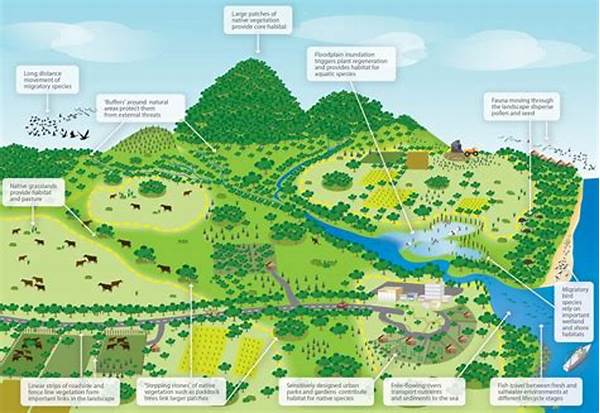Hey there, nature enthusiasts! 🌿 Have you ever wandered through a serene rural landscape and wondered about the rich tapestry of life thriving within? Today, we’re diving into the lush world of rural landscape biodiversity conservation. It might sound like a mouthful, but trust me; it’s worth your attention. Let’s explore why these landscapes are so vital to our planet’s health and why conserving them matters now more than ever.
Read Now : Family Teamwork In Water Parks
The Importance of Rural Landscape Biodiversity Conservation
Okay, picture this: a sprawling countryside with rolling hills, bubbling streams, and a kaleidoscope of wildflowers. This idyllic scene isn’t just a treat for the eyes; it’s a living, breathing ecosystem packed with biodiversity. In rural landscapes, biodiversity conservation involves safeguarding various species and their habitats to maintain ecological balance. Without these efforts, we risk losing precious flora and fauna, which can disrupt food chains and degrade ecosystems. Plus, rural landscapes act as natural carbon sinks, helping to combat climate change. So, conserving biodiversity isn’t just about protecting wildlife; it’s about preserving the planet. Every plant and animal plays a role in this intricate web of life, and by conserving rural landscapes, we’re investing in a sustainable future.
How We Can Help with Rural Landscape Biodiversity Conservation
1. Community Involvement: Engage local communities in rural landscape biodiversity conservation efforts to instill a sense of ownership and responsibility.
2. Sustainable Farming Practices: Encourage practices that support soil health and contribute to rural landscape biodiversity conservation.
3. Educational Programs: Implement initiatives that raise awareness about the importance of rural landscape biodiversity conservation.
4. Government Policies: Advocate for policies that prioritize rural landscape biodiversity conservation through incentives and regulations.
5. Research and Innovation: Support research projects that explore new methods of rural landscape biodiversity conservation.
Challenges in Rural Landscape Biodiversity Conservation
Whenever we chat about rural landscape biodiversity conservation, the number one challenge is striking a balance between human activities and nature. It’s like trying to juggle while riding a unicycle! 😅 Agricultural practices, urbanization, and climate change exert enormous pressure on these landscapes. One of the trickiest parts? Ensuring that development projects, which are vital for economic growth, don’t trample on local biodiversity. Another tough nut to crack is awareness. Getting people to understand and value the richness embedded within these rural landscapes is crucial. We need to foster a global mindset where rural landscape biodiversity conservation is seen as an integral part of sustainable living, not an isolated act of preserving just for the sake of it.
Strategies for Effective Rural Landscape Biodiversity Conservation
1. Habitat Restoration: Reestablishing native flora can greatly enhance rural landscape biodiversity conservation efforts.
2. Wildlife Corridors: Connecting fragmented habitats is vital for species movement and rural landscape biodiversity conservation.
3. Controlled Grazing: Utilizing rotational grazing can aid in rural landscape biodiversity conservation by preventing overgrazing.
4. Water Conservation: Implementing strategies to preserve water bodies helps in rural landscape biodiversity conservation.
Read Now : Nature Immersion For Relaxation
5. Eco-friendly Tourism: Promoting tourism that respects the environment supports rural landscape biodiversity conservation.
6. Monitoring Programs: Regular assessments help in identifying the efficacy of rural landscape biodiversity conservation measures.
7. Invasive Species Management: Actively managing invasive species is crucial to rural landscape biodiversity conservation.
8. Conservation Funding: Securing financial resources is necessary for sustained rural landscape biodiversity conservation programs.
9. Public Engagement: Citizens can volunteer in rural landscape biodiversity conservation initiatives, increasing grassroots support.
10. Partnerships: Collaborations among NGOs, governments, and businesses are vital for rural landscape biodiversity conservation success.
Why We Should Prioritize Rural Landscape Biodiversity Conservation
So why, you ask, should we prioritize rural landscape biodiversity conservation today? Well, it’s the foundation for robust ecosystems. These landscapes are biodiversity hotspots, housing countless plant and animal species that we sometimes take for granted. By conserving these areas, we’re not just maintaining pretty views—this is about ensuring food security, medicinal resources, and climate resilience. Additionally, rural landscapes offer us cleaner air and water, so it’s like receiving a generous gift from nature. Ignoring their conservation could mean compromising future generations’ well-being. Remember, the rural landscape biodiversity conservation isn’t merely an environmental endeavor; it’s a commitment to a thriving planet. Let’s be part of the solution, championing conservation efforts and encouraging others to do the same.
The Future of Rural Landscape Biodiversity Conservation
As we gaze into the crystal ball, it’s clear the future of rural landscape biodiversity conservation hinges on our actions today. With more innovative approaches and collaborative efforts, we can nurture our landscapes back to health. From the implementation of high-tech monitoring systems to grassroots movements, every effort counts. The goal is to create a sustainable, biodiverse future where humans and nature coexist harmoniously. By fostering partnerships across sectors and engaging community stakeholders, the blueprints for future rural landscape biodiversity conservation initiatives are already forming. Let’s embrace this journey with open hearts and minds, realizing the path to conservation is a collective endeavour. After all, the beauty and bounty of our rural landscapes are treasures worth safeguarding for the years to come.



